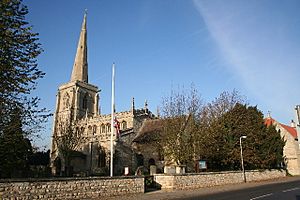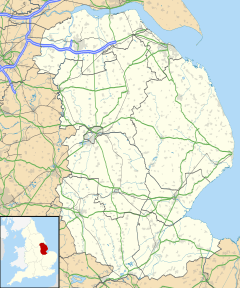Ancaster, Lincolnshire facts for kids
Quick facts for kids Ancaster |
|
|---|---|
 St Martin's Church, Ancaster |
|
| Population | 1,317 (2001) |
| OS grid reference | SK983438 |
| • London | 100 mi (160 km) S |
| District |
|
| Shire county | |
| Region | |
| Country | England |
| Sovereign state | United Kingdom |
| Post town | Grantham |
| Postcode district | NG32 |
| Dialling code | 01400 |
| Police | Lincolnshire |
| Fire | Lincolnshire |
| Ambulance | East Midlands |
| EU Parliament | East Midlands |
| UK Parliament |
|
Ancaster is a village in Lincolnshire, England. It is located in the South Kesteven area. Ancaster was built on the site of an old Roman town. In 2011, about 1,647 people lived here. The nearby areas of Sudbrook and West Willoughby are also part of Ancaster's local parish.
Ancaster is connected to some important historical titles. These include the Duke of Ancaster and Kesteven and the Earl of Ancaster.
Contents
History
Ancaster has a very long and interesting history. It was once a Roman town. This town was important because two major Roman roads met there: Ermine Street and King Street.
Roman Times
During the Roman-British period, the Romans built a settlement here. It was on the site of an even older local tribe's settlement. Ancaster is on Ermine Street, a big Roman road that went north from London.
Near Ancaster, you can still see some old Roman earthworks. These are like ancient ditches and banks. Archaeologists have found a cemetery with over 250 Roman burials. Some of these were in special stone coffins called sarcophagi. Later, the Romans built a large stone wall and ditches around the town. This was probably to protect it from invading Saxons.
Name Origin
The name Ancaster first appeared in old documents from the 1100s. It means "the Roman fort of 'Anna'."
Archaeological Discoveries
In 2002, the TV show Time Team dug in Ancaster. They found a special burial site with an inscription to a god called Viridius. They also found pottery from the Iron Age and Roman times. A brooch from the 1st century and parts of the Roman town wall were also discovered.
Tall Thrift Plant
In 2005, a rare plant called tall thrift was found in Ancaster churchyard. This plant is very uncommon. Ancaster is one of only two places in the country where it grows. Special plans were made to protect it.
Ancaster, Canada
There is a town called Ancaster in Canada. It was named after Ancaster, Lincolnshire, in 1792. A British army officer, John Simcoe, named it. He was inspired by the 3rd Duke of Ancaster, Peregrine Bertie.
Geography
Ancaster is located between the towns of Sleaford and Grantham. It sits on the A153 road, where it meets the B6403. This B6403 road is also known as High Dike north of the village. It forms the border between South and North Kesteven.
The River Trent used to flow through this area. It went east from Nottingham towards the North Sea. It passed through the Vale of Belvoir and the Ancaster gap in the limestone hills.
The local parish of Ancaster also includes the small settlements of Sudbrook and West Willoughby.
Amenities
Ancaster has several useful places for its residents.
- There is a Church of England primary school.
- You can find a butcher and a grocery shop.
- The village has a small railway station. It is on the Nottingham–Skegness line.
- There is also a post office and a petrol station.
- The Railway Inn is one of the local pubs.
- A sports and social club is linked to the playing field. This field is home to the Ancaster Cricket Club.
- West of the village, on Willoughby Moor, there is a holiday park.
- Ancaster also has two nearby nature reserves. These are special areas where the rare tall thrift plant can be found.
Church
The village's main church is St Martin's Church, Ancaster. It is a very old and important building. It is a Grade I listed building, meaning it has special historical value. The church is dedicated to St Martin. He was a Roman soldier who became a Christian saint. Many churches on old Roman sites are named after him.
Church History and Features
St Martin's Church stands on Ermine Street. It is likely built on the site of an old Roman temple. The church was first mentioned in documents around 1200. This was when the body of Bishop Hugh rested there overnight.
The church has beautiful Norman arches. It also has an Early English font. Look closely at the corbels (stone supports) inside. They have medieval carvings of people. You might see a nun drinking, an older woman, and a farmer. There is also a "Green Man" carving in the vestry. You can also find the remains of a Sheela na gig carving on the north side of the tower. More figures are carved on the wooden ceiling. In the 1960s, two Roman sculptures were found on the East Wall of the church.
The church is part of the Diocese of Lincoln. It is linked with the church in Wilsford.
See also
 In Spanish: Ancaster para niños
In Spanish: Ancaster para niños


